What is the make up of the respiratory system?
| Structure | Function |
|---|---|
| Nasal cavity | Air is warmed and filtered as it enters the body |
| Trachea | Brings air into the lungs. Supported by rings of cartilage that prevent it collapsing |
| Bronchus | Branches off the trachea to bring air into the lungs. Also supported by rings of cartilage |
| Bronchiole | Branch off the bronchi |
| Alveoli | Small air sacs that are the site of gas exchange |
| Lung | Organ where gas exchange occurs |
| Ribs | Protect internal organs of the thorax |
| Thorax | Part of the body between the neck and abdomen |
| Intercostal muscles | Muscles between the ribs that aid breathing |
| Diaphragm | Sheet of muscle below the ribs that aids breathing |
| Pleural membranes | Thin layers that reduce friction between the lungs and the inside of the chest wall during breathing |
| Pleural fluid (Higher Tier) | Fluid found in the pleural cavity (between the pleural membrane layers). It further reduces friction during breathing |
| Thorax | Part of the body between the neck and abdomen |
How is the respiratory system adapted?
Respiratory surfaces
In humans
Gas exchange occurs in the alveoli which are found in the lungs.

When air is inhalationThe action of breathing in., oxygen diffuses from the alveoli into the blood to be used for respiration by the body’s cells.
Carbon dioxide is a waste product made by the body’s cells during respirationThe chemical change that takes place inside living cells, which uses glucose and oxygen to release the energy that organisms need to live. Carbon dioxide is a by-product of respiration..
It diffusionThe random movement of a substance from a region of high concentration to a region of low concentration. from the blood into the alveoli and is exhalationThe action of breathing out..
Adaptations of the alveoli:
Large surface area - many alveoli are present in the lungs with a shape that further increases surface area.
Thin walls - alveolar walls are one cell thick providing gases with a short diffusion distance.
Moist walls - gases dissolve in the moisture helping them to pass across the gas exchange surface.
Permeable walls - allow gases to pass through.
Good blood supply - ensuring oxygen rich blood is taken away from the lungs and carbon dioxide rich blood is taken to the lungs.
A large diffusion gradient - breathing ensures that the oxygen concentration in the alveoli is higher than in the capillaries so oxygen moves from the alveoli to the blood. Carbon dioxide diffuses in the opposite direction.
In plants
Gas exchange occurs in the spongy mesophyllThe plant tissue in a leaf which has loosely packed cells and air spaces between them to allow gas exchange. cells that surround air spaces in the leaves.
Adaptations of the leaf:
- Large surface area - spongy mesophyll cells are in contact with the air spaces for gas exchange.
- Thin walls - gases have a short diffusion distance.
- Moist walls - gases dissolve in the moisture helping them to pass across the gas exchange surface.
- Permeable walls - allow gases to pass through.
- A large diffusion gradient – allows efficient gas exchange as carbon dioxide diffuses from high concentration in the air space into the cells, while oxygen moves in the opposite direction.
Breathing
A lung model can be used to demonstrate the process of breathing.
In the lung model
Inhalation:
- The diaphragmA large sheet of muscle that separates the lungs from the abdominal cavity. (rubber sheet) moves down
- The human thoraxThe ribs and upper backbone, and the organs found in the chest. (glass jar) volume increases, lowering pressure
- Air enters, inflatingTo fill with air. the lungs (balloons) until pressure inside equals outside
Exhalation:
- The diaphragm moves up
- The thorax volume decreases, raising pressure
- Air exits, deflating the lungs until pressures balance
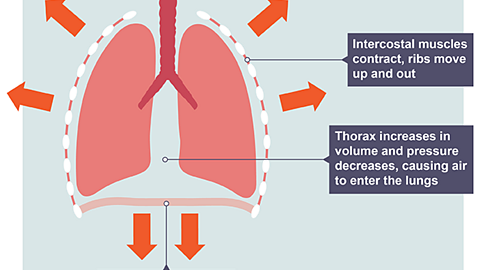
Image caption, Inhalation
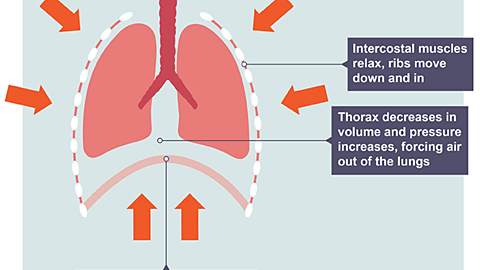
Image caption, Exhalation
1 of 2
There are a few differences between the model and real breathing:
- The model lacks ribs and intercostal muscles, which move during real breathing to change thorax volume
- The diaphragm is really dome-shaped and flattens during inhalation, while in the model, a flat rubber sheet is pulled down
- The space between the lungs and wall of the thorax is very small but the model shows a large space
Effect of exercise on breathing rate and depth
During exercise, muscle contraction requires more energy. Energy is released during respirationThe chemical change that takes place inside living cells, which uses glucose and oxygen to release the energy that organisms need to live. Carbon dioxide is a by-product of respiration..
Your body needs more oxygen and produces more carbon dioxide due to increased respiration.

To handle this:
- breathing rate increases: you take more breaths per minute to bring in more oxygen and remove carbon dioxide.
- breathing depth increases: allowing more air to enter and leave your lungs.
This helps supply your muscles with more oxygen and gets rid of the extra carbon dioxide.
The harder you exercise, the faster and deeper you breathe.
The time taken for the breathing rate to return to normal is known as the recovery time.
This can be used as a measure of fitness as fitter people have a shorter recovery time.
Respiration
Respiration is an exothermicA chemical reaction that releases energy. reactions that occur in the mitochondriaThe site of cell respiration. of cells to release energy.
This energy can then be used for
- heat
- movement
- growth
- reproduction
- active uptake
There are two types of respiration - aerobic and anaerobic.
Aerobic respiration
Aerobic respiration happens in the presence of oxygen and releases more energy than anaerobic respiration.
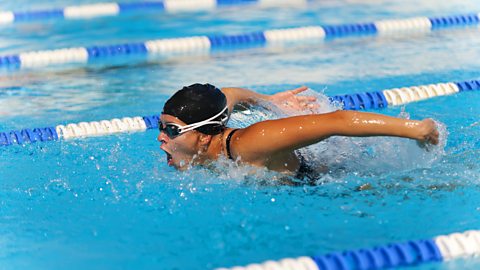
Aerobic respiration word equation:
glucose + oxygen → carbon dioxide + water + energy
Aerobic respiration balanced chemical equation:
\(\ce{C6H12O6 + 6O2 → 6CO2 + 6H2O + energy}\)
Exploring aerobic and anaerobic respiration
Anaerobic respiration
Anaerobic respiration happens in the absence of oxygen.
It occurs during strenuous exercise. The build up of lactic acidA toxic chemical produced during anaerobic respiration. causes muscle cramps.
Anaerobic respiration word equation (in mammalian muscle cells):
glucose → lactic acid + energy
Anaerobic respiration word equation (in yeast cells):
glucose → alcohol + carbon dioxide + energy
The alcohol produced is the basis of wine and beer production.
Compare and contrast aerobic and anaerobic respiration
Similarities - both:
- Release energy
- Occurs in both plants and animals
- Catalysed by enzymes
Differences -
| Aerobic | Anaerobic | |
|---|---|---|
| Oxygen | Needed | Not needed |
| End products | Carbon dioxide and water | Animal cells: lactic acid. Plant cells and yeast: carbon dioxide and ethanol |
| Energy released | Relatively large amount | Relatively small amount |
| Occurs in | Mitochondria | Cytoplasm |
Practical 1.5 - Investigate factors affecting the respiration of yeast
Temperature - procedure
- Mix yeast, glucose, and water; leave for 30 minutes at 20°C.
- Place 20 ml of yeast solution in a boiling tube.
- Attach a bung with a delivery tube into water.
- Place the boiling tube in a water bath at 20°C.
- After 5 minutes, count the bubbles produced for 1 minute.
- Repeat steps 2-5 at different temperatures (e.g., 30°C, 40°C, 50°C, 60°C).
- Record the results in a table.
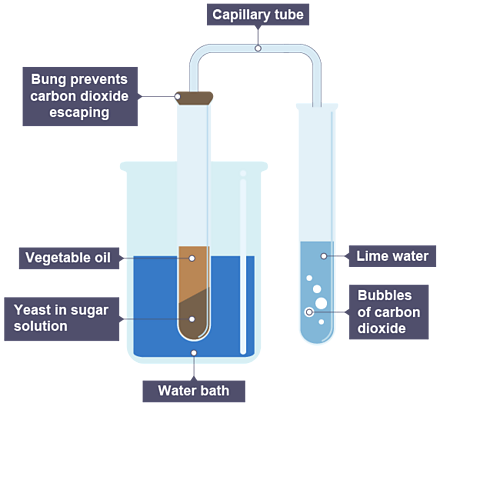
Results
| Temperature / °C | Number of bubbles |
|---|---|
| 20 | 4 |
| 30 | 8 |
| 40 | 20 |
| 50 | 2 |
| 60 | 0 |
Conclusion:
The higher the temperature, the faster the rate of respiration due to increased kinetic energy.
The optimum temperature was 40°C, where the most bubbles of carbon dioxide were produced. Above 50°C, enzymes become denatured, or the yeast is killed.
Independent variable : temperature / °C
Dependent variable: number of bubbles (rate of respiration)
Controlled variables: volume and concentration of yeast solution, time
Further factors to investigate: different sugars
- Follow steps 1-5 from the previous experiment, using different sugars (eg, sucrose, fructose, lactose, maltose) or varying amounts (1g, 2g, 3g, 4g, 5g).
Ensuring anaerobic respiration
- Boil the glucose solution to sterilise and remove oxygen.
- Cool it before adding the yeast (high temperatures will kill it).
- Add a layer of oil on top to prevent oxygen entry.
How much do you know about the respiratory system?
More on Living processes
Find out more by working through a topic
- count5 of 6

- count6 of 6
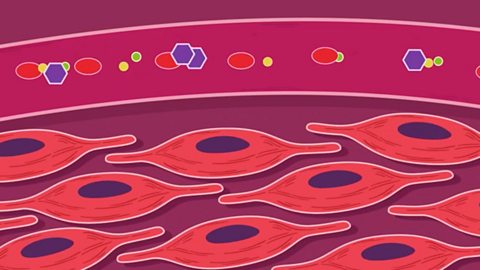
- count1 of 6
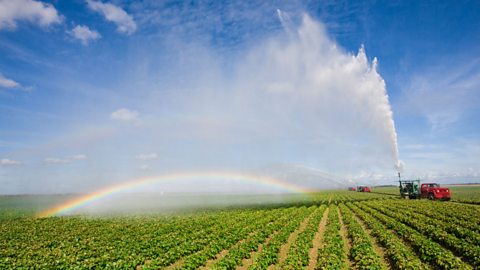
- count2 of 6
